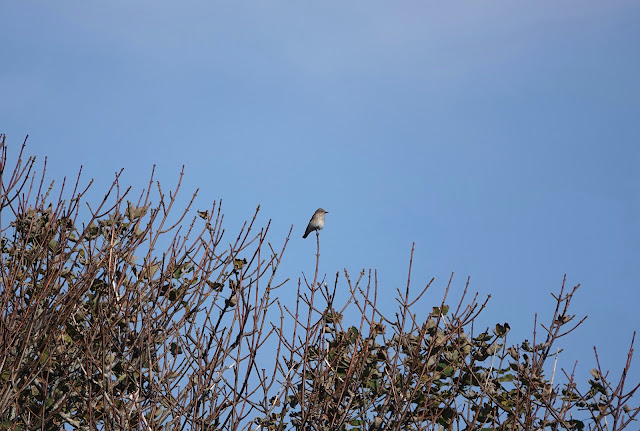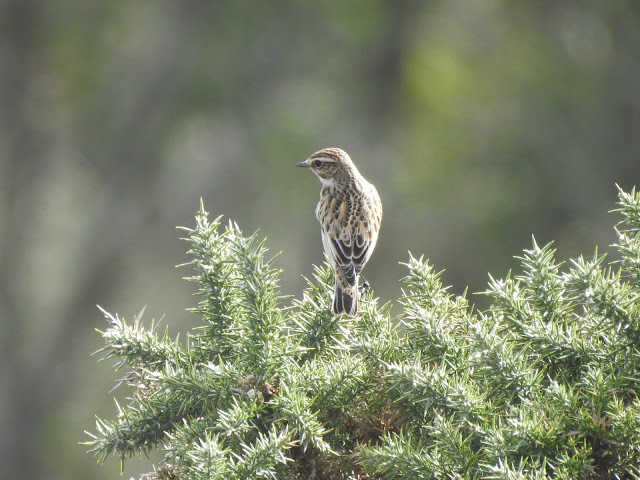Easterlies on the 18th which strengthened into the 19th. A short period of calm on the 20th allowed incredible migrant passage before some strong southerly winds returned on the 21st. The week finished with moderate prevailing winds.
Coverage has remained excellent this week and we have
enjoyed a record breaking passage of winter thrushes, as well as a few nice
arrivals of birds that are uncommon on Lundy such as Wigeon, Jackdaw, Great Spotted Woodpecker, Hen Harrier, Hobby and
several species of small gull.
 |
| Dawn over Millcombe © Tim Jones |
The first Wigeon
of the year was found on Quarter Wall Pond on the 23rd and a female Teal has been present all week at
Pondsbury.
Two Stock Doves
were seen on the 18th and just one on the 19th. Water Rail can be heard
calling quite regularly in Millcombe Valley, and up to three individuals have
been recorded this week.
We have had a subtle influx of Lapwing, with two roosting overnight on the 19th and a flock of six
spent the day in various fields in the south of the island. Another single bird
was present on the 23rd up by the airstrip. We had four Golden Plover on the 17th
and three were seen heading out to sea on the morning of the 18th. One more was
heard calling on the 20th. Dunlin singles
have been heard most days, and on the 20th three Dunlin flew over Stoneycroft before heading out to sea, accompanied
by a single Ringed Plover. One Turnstone was with three Oystercatcher
in the Landing Bay on the 21st. High count of Snipe for the week was five individuals present or flying over on
the 19th. A single Jack Snipe was by
Pondsbury on the 19th.
There was a large movement out to sea off of the east coast
on the 21st and 1550 Kittiwake were
recorded along with three Arctic Skua, six Mediterranean Gulls, 10 Common Gull, 30 Great Black-backed Gull, 70 Gannets and 1500 Auks spp. Another single Mediterranean
Gull was seen on the 17th and single
Arctic Skuas were seen on the 18th and 19th. 27 Lesser Black-backed Gulls were recorded on the 19th, with small numbers present every day
this week. A Great Skua was picked up off of the west coast
on the 19th as well as six Manx Shearwaters and 124 Gannets, while three ‘Commic Terns’ were seen on the east
coast. Four Cormorants were seen flying
together on the 18th.
This week three Sparrowhawks
have been seen every day (one male and two females). Most excitingly we have
had two separate ringtail Hen Harriers passing through, one juvenile
male briefly seen and then heading out to sea on the 18th. Another bird was
seen in the afternoon of the 23rd working its way along the west coast. It was
then seen again low over Bartons Field at 6pm before heading north to roost for
the night. A late juvenile Hobby also
spent the night on the island on the 19th, seen from Government at dusk and
picked up at first light from Millcombe on the 20th. Merlins have been noticeably moving through too with some seen
arriving in off of the sea or departing south. The highest count for Merlin was three birds on the 17th,
with two individuals on the 19th and 21st. The high count for Peregrine Falcon was five on the 23rd, which is the most for a while.
 |
| Merlin, Halfway Wall © Tom Wright |
A single Jackdaw was
seen near Quarter Wall on the 22nd, another for the year list(!). It has moved
towards the village on the 23rd, also seen in Barton’s Field and even found in
the garden of the lodge in the evening of the 23rd! Furthermore, a Great Spotted Woodpecker was
seen flying east over Lighthouse Field on the 19th, another uncommon bird on
Lundy – a description species no less!
 |
| Jackdaw, Brick Field © Stuart Cossey |
Skylarks have
still been moving over on the less windy days, with 70 on the 18th and 40-50
towards the end of the week. Swallows
have continued to trickle through with 10-20 most days and 49 on the 23rd. One House Martin was seen on the 18th.
A couple of very late Willow
Warblers have popped up with one
ringed in Millcombe on the 20th and seen at Quarter Wall just a couple of hours
later. Up to seven Chiffchaffs have
been present, mostly in Millcombe and along the lower east path. Max Blackcap count has reduced to 20. A Firecrest continued to be present all
week, with two birds seen on the 18th. Goldcrest
numbers have dropped substantially though with 22 on the 17th reducing to
totals between 4 and 9 for the rest of week, with the exception of Saturday
when 15 were recorded. The week has seen quite a few sightings of Yellow-browed Warblers, sometime with
two in Millcombe as well as one Spotted
Flycatcher on the 20th.
 |
| Spotted Flycatcher, Millcombe © Tim Jones |
 |
| Yellow-browed Warbler, Smelly Gully © Tim Jones |
The weather system in the North Sea this week has opened the floodgates to migrants coming south, and the UK has been flooded with huge numbers of thrushes. Here on Lundy we have seen an unusual balance of substantially more Fieldfare than Redwing, with 4000 Fieldfare passing over on the 20th along with 700 Redwing. This more than doubles the last previous maximum daily total for Fieldfare. The bird movements on this day was an out and out spectacle, and picking through the masses of thrushes also resulted in: 23 Song Thrush, 20 Ring Ouzel, a Mistle Thrush, 1200 Chaffinch, 75 Siskin and 8 Reed Bunting. Starlings have been moving through as well with a peak of 350 on the 19th and 200 most other days. Our resident flock typically numbers about 130.
 |
| Ring Ouzel, Millcombe © Tim Jones |
 |
| Fieldfare © Tim Jones |
 |
| Fieldfare, Tillage Field © Tom Wright |
Increased numbers of Black Redstart have been recorded on the 19th-21st, with four individuals on the 20th. Another very late Whinchat was picked up on the east coast on the 21st and later seen by rocket pole. Stonechats number between 10-20 each day. One perhaps final Wheatear was recorded near Tibbets on the 17th. About 80 Meadow Pipits have been moving through each day after a strong start to the week with 400 on the 18th.
 |
| Whinchat, St Helens Copse © Stuart Cossey |
A few Yellow Wagtails were moving through towards
the end of the week with one or two every day since the 20th. There was a
smattering of Grey Wagtails too with a couple most days,
one that was tantalisingly close to mist nets in Millcombe but unfortunately
wasn’t successfully caught. Highest count of Pied/White Wagtails was 39 on the very busy 20th October!
Goldfinches and Linnets have been in very low numbers
this week, with singles or pairs of Goldfinches
only amounting to a weekly max of 25 on the 22nd, and a minimum of 3 on the
23rd. There were 22 Linnets on the
18th, but just 6 on each of the following three days. A couple of Lesser Redpoll were picked up towards the end of the week in what seems to
be a poor year for this species. However
Chaffinches were consistently moving
through in fairly high numbers (several hundred every day and 2000 on the 18th),
and there are good numbers of Siskin
too, with a high count of 125 on the 22nd. More Brambling have also been recorded with a cumulative total of 21,
most of which were early in the week (max daily total of seven on the 19th).
One Greenfinch flew over on the 23rd
and the weak call of what is proving to be an extremely elusive Bullfinch has been heard on the 19th
and 20th, with just one sighting alerting us that it is a male.
Up to eight Snow Buntings were seen this week,
delighting visitors on the main track with their apparent fearlessness. There
were 19 records of Reed Bunting this week, with a max of eight
on the 20th.
 |
| Reed Bunting, Millcombe © Tim Jones |
A few late Small Copper butterflies have been recorded
this week as well as up to four Hummingbird
Hawk-moths in Millcombe on the 17th.
Contributors: Stuart Cosset, Rosie Ellis, Angus Croudace, Tom Wright, Tim Jones, Tim Davis, Tim Worfolk, Paul Holt, Chris Baillie, Nik Ward, Greg Conway, David Lindo, Andy Jayne
Stunning photo of the Merlin!
ReplyDelete